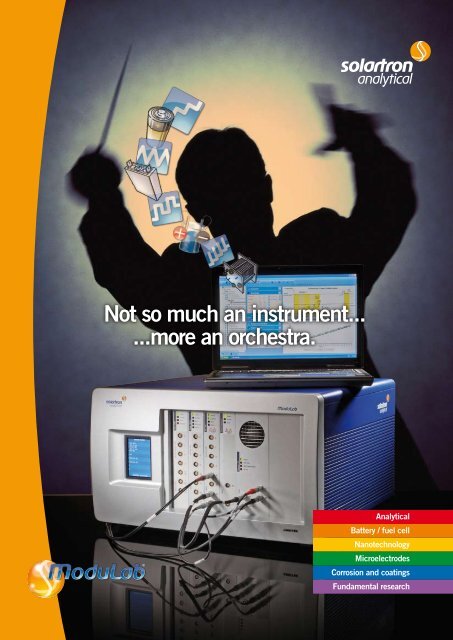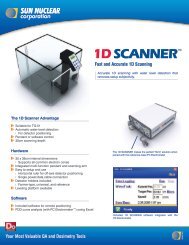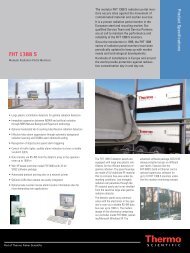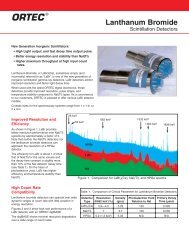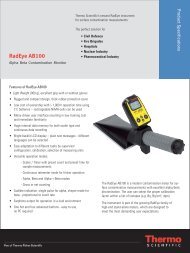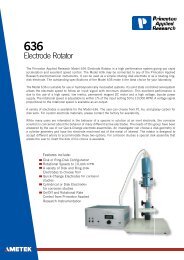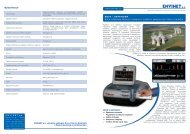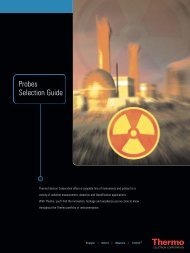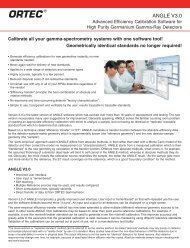Not so much an instrument... ...more an orchestra.
Not so much an instrument... ...more an orchestra.
Not so much an instrument... ...more an orchestra.
Create successful ePaper yourself
Turn your PDF publications into a flip-book with our unique Google optimized e-Paper software.
ard for electrochemical researchThe options work together, eachcomplementing rather th<strong>an</strong> compromisingthe facilities of the other, providing virtuallyunlimited test capability for the researcher.The ModuLab system utilizes the lateststate-of-the-art over-sampling signalprocessing technology to provide ultrasmooth<strong>an</strong>alog cyclic voltammetrywaveforms no matter which combinationof options are used, even when operatingat extreme >10kV/s sc<strong>an</strong> rates. Thesmooth sc<strong>an</strong> waveform generator capabilityensures that cells are not disturbedby undesired steps <strong>an</strong>d tr<strong>an</strong>sients, forModuLab “smooth sc<strong>an</strong>” me<strong>an</strong>s just that.The high-re<strong>so</strong>lution digital techniquesemployed ensure precise waveformgeneration <strong>an</strong>d <strong>an</strong>alysis over the completer<strong>an</strong>ge of sc<strong>an</strong> speeds without ch<strong>an</strong>gingmodes of operation or connections.As you might expect from a Solartronsystem, the r<strong>an</strong>ge <strong>an</strong>d capability ofimped<strong>an</strong>ce techniques provided byModuLab are second to none. Singlesine, multi-sine / FFT <strong>an</strong>d harmonic<strong>an</strong>alysis are provided throughout theentire frequency r<strong>an</strong>ge of the system. Thefrequency response <strong>an</strong>alyzer (FRA) uses40x over-sampled data acquisition <strong>an</strong>dwaveform generation to ensure the purity<strong>an</strong>d accuracy of the results. Any of theabove imped<strong>an</strong>ce <strong>an</strong>alysis techniquesmay be used for AC staircase (or linear)voltammetry / potentiometry providingcomplete cell characterization (imped<strong>an</strong>cevs. frequency vs. DC polarization).System ConfigurationThe ModuLab system c<strong>an</strong> be “plug <strong>an</strong>dplay” configured in m<strong>an</strong>y different ways,from a single potentiostat with options ina chassis, to several potentiostats in thesame chassis, or multiple chasses eachwith multiple potentiostats in <strong>an</strong> extendedsystem. Several potentiostats c<strong>an</strong> becontrolled from a single PC, or multiplePCs may be integrated into the systemeach controlling groups of potentiostatsas required. Additional potentiostats <strong>an</strong>doptions may be added into a chassis at <strong>an</strong>ytime. Each option module carries its owncalibration, <strong>so</strong> it really is as easy as plug<strong>an</strong>d play to add to the system. The frontp<strong>an</strong>el of the chassis is easily removed <strong>an</strong>dnew modules c<strong>an</strong> then be inserted whichare detected by the <strong>so</strong>ftware when thesystem powers on.ModuLab: the world’smost flexible modularelectrochemical test system
ApplicationsFundamental researchCorrosion <strong>an</strong>d coatingsMicroelectrodesN<strong>an</strong>otechnologyBattery / fuel cellAnalyticalHigh perform<strong>an</strong>ce ‘Plug & Play’ modules64 MS/s smooth sc<strong>an</strong> - LSV, LSP, CVUp to 1 MS/s data acquisition - pulse, CV100 aA current re<strong>so</strong>lutionUp to ±25 A current - sc<strong>an</strong> / pulse±100 V compli<strong>an</strong>ce <strong>an</strong>d polarization10 µΩ imped<strong>an</strong>ce measurement>100 TΩ imped<strong>an</strong>ce measurementMultiple high-speed EIS techniquesFuel cells, batteries <strong>an</strong>d supercapacitorsThe ModuLab system is able tocharacterize a wide r<strong>an</strong>ge of celltechnologies at a research <strong>an</strong>ddevelopment level. Smaller batteries,supercapacitors <strong>an</strong>d micro fuel cells, suchas those used in mobile communications<strong>an</strong>d PC applications c<strong>an</strong> be tested directlyby ModuLab. For testing higher powercells, potentiostats may be connected inparallel or external power booster optionsmay be added to the system.In addition to st<strong>an</strong>dard DC multi-ch<strong>an</strong>nelexperimental techniques such as cyclicvoltammetry, charge / discharge cycling,<strong>an</strong>d ohmic-drop measurements, ModuLabprovides m<strong>an</strong>y specialized capabilitiesincluding <strong>an</strong>ode / cathode imped<strong>an</strong>cemeasurements. The capability to providecomplete cell imped<strong>an</strong>ce characterizationis very import<strong>an</strong>t for the improvement ofcell electrode perform<strong>an</strong>ce.There is al<strong>so</strong> interest in harmonic <strong>an</strong>alysisfor fuel cells which provides diagnosticinformation to determine the health of the cell.Mobile phone device test applications areal<strong>so</strong> fully supported with the ability to runGSM <strong>an</strong>d CDMA pulse applications. Highdata acquisition rates <strong>an</strong>d flexibility of datacapture capabilities are very import<strong>an</strong>tfacilities for these applications.Combinations of options such as auxiliarych<strong>an</strong>nels, high voltage, power boosters<strong>an</strong>d FRAs are used to run continuousimped<strong>an</strong>ce <strong>an</strong>d DC tests on multiple cellsin a battery or fuel cell stack, looking forearly signs of deterioration in individualcells. Stacks with overall voltage as high as100 volts may be <strong>an</strong>alyzed in this way.
To discuss how ModuLab could benefit your specificapplication, contact your local Solartron representative.There are m<strong>an</strong>y other applications including sen<strong>so</strong>r development <strong>an</strong>dbio-research, where the r<strong>an</strong>ge of facilities <strong>an</strong>d options of ModuLab willCorrosion <strong>an</strong>d CoatingsModuLab is a fully floating system allowingmeasurements to be taken in the mostdifficult circumst<strong>an</strong>ces. The high voltage<strong>an</strong>d femto ammeter options provide m<strong>an</strong>ypossibilities for testing extremely highimped<strong>an</strong>ce corrosion coatings. The systemal<strong>so</strong> provides equivalent circuit <strong>an</strong>d Tafeldata fitting techniques, Linear PolarizationResist<strong>an</strong>ce measurements <strong>an</strong>d corrosionresult displaysThe ModuLab system was designed withvoltage <strong>an</strong>d current noise experiments inmind, providing accurate <strong>an</strong>d consistentdata that may be used in electrochemicalnoise studies. The ModuLab potentiostatmakes use of virtual earth (Zero Resist<strong>an</strong>ceAmmeter - ZRA) measurement technology<strong>an</strong>d provides high-speed acquisition <strong>an</strong>dhigh sensitivity measurements that are arequirement for this application4e-132e-13N<strong>an</strong>otechnologyMicroelectrodesFrom the outset, ModuLab was designedto measure electrode processes on ultramicroelectrodessuch as carbon n<strong>an</strong>otubes<strong>an</strong>d Atomic Force Microscope (AFM)tips. ModuLab’s femto ammeter option,coupled with a comprehensive suite ofelectrochemical measurement techniques,provides ultra-low current potentiodynamic<strong>an</strong>d galv<strong>an</strong>odynamic DC measurements.In combination with a frequency response<strong>an</strong>alyzer (FRA), extremely high imped<strong>an</strong>cemeasurements are possible (>100 Tohms).Measurements on n<strong>an</strong>o-devices requirecareful screening from <strong>so</strong>urces of noise<strong>an</strong>d interference. The femto ammeteroption achieves this with double screenedshielding for the measurement electronics,triax cabling <strong>an</strong>d high stability referenceresistors.AnalyticalFundamental ResearchModuLab is able to measure at extremelyhigh data acquisition rates (up to 1 MS/s)which is ideal for high speed sweep, pulseor step <strong>an</strong>alytical techniques such asfast cyclic voltammetry CV <strong>an</strong>d normal /differential pulse voltammetry NPV / DPV.ModuLab provides ultra-smooth sc<strong>an</strong>nedwaveforms (for example in CV cyclicvoltammetry <strong>an</strong>d LSV linear sweepvoltammetry). Ultra-high sample rates <strong>an</strong>dinterpolation filtering provide the precision<strong>an</strong>d stability of digital waveforms whilemaintaining the smoothness of <strong>an</strong>alogsweeps. The femto ammeter option mayal<strong>so</strong> be utilized for extremely sensitivecurrent measurement applications.Choice of data acquisition mode isprovided for all step types, <strong>so</strong> the shapeof the current response to a sequenceof DPV pulses may easily be monitoredallowing optimization of data capture. Theflexibility of the experiment sequencingallows <strong>an</strong>y combination of techniques tobe sequenced automatically <strong>an</strong>d repeatedusing loops.0100fA-2e-13-4e-13Current Density40 45 50 55 60 65 70 75Time (s)There are m<strong>an</strong>y other applications including sen<strong>so</strong>r development <strong>an</strong>dbio-research, where the r<strong>an</strong>ge of facilities <strong>an</strong>d options of ModuLab willundoubtedly prove to be very beneficial.To discuss how ModuLab could benefit your specificapplication, contact your local Solartron representative.undoubtedly prove to be very beneficial.
ModulesPotentiostat / galv<strong>an</strong>ostat(Pstat 1 Ms/s)The core of the ModuLab system is itspotentiostat / galv<strong>an</strong>ostat which makes useof the latest Digital Signal Proces<strong>so</strong>r (DSP)technology to provide accurate experimentcontrol, high-speed data acquisition, dataaveraging <strong>an</strong>d responsive safety <strong>an</strong>d steplimit detection. The ModuLab potentiostatprovides:Smooth waveform generation usinghigh sample rates (64 MS/s) <strong>an</strong>dinterpolation filtering to deliver theaccuracy, stability <strong>an</strong>d control of digitalwaveform technology with all of thesmoothness of <strong>an</strong>alogue techniques.High-speed data acquisition up to1 MS/s used for pulse <strong>an</strong>d fast CVtechniques.Exceptional b<strong>an</strong>dwidth for accurate<strong>an</strong>d reliable high-speed CV, pulse<strong>an</strong>d imped<strong>an</strong>ce measurements at allfrequencies <strong>an</strong>d imped<strong>an</strong>ce levels(using <strong>an</strong> FRA option).Floating electrode capability formeasurements on grounded cells,autoclaves, pipelines <strong>an</strong>d storage t<strong>an</strong>ks.Flexible experiment sequencing thatallows high data acquisition rates atthose specific points in the experimentwhere it is needed, e.g. for <strong>an</strong>alysis ofpulses or high speed CVs.An extensive r<strong>an</strong>ge of <strong>an</strong>alyticalelectrochemistry techniques, plusthe ability to sequence techniques toperform charge / discharge cycling,chronoamperometry <strong>an</strong>d combined DC<strong>an</strong>d imped<strong>an</strong>ce experiments.Inst<strong>an</strong>t<strong>an</strong>eous switching betweenexperiment steps provides a greatdeal of flexibility for defining charge/ discharge experiment protocols forbattery applications <strong>an</strong>d for <strong>an</strong>alyticalapplications.Frequency Response response <strong>an</strong>alyzer options(FRA 1 MHz / FRA 300 KHz)The frequency response <strong>an</strong>alyzers (FRA)used in the ModuLab system are thehighest perform<strong>an</strong>ce <strong>an</strong>alyzers availabletoday. The FRA is able to measure in all ofthe following modes of operation across itsentire frequency r<strong>an</strong>ge (from 10 μHz to1 MHz):Single sine correlation providesunbeatable measurement accuracy <strong>an</strong>drepeatability. The ModuLab FRA takesimped<strong>an</strong>ce measurement perform<strong>an</strong>ceto a higher level by combining the bestquality <strong>an</strong>alog hardware design withthe latest generation high-speed DigitalSignal Proces<strong>so</strong>r (DSP) technology toprovide even greater measurementspeed <strong>an</strong>d accuracy (1 MHz to 10 Hz,10 points / decade in just five seconds).Multi-sine / Fast Fourier Tr<strong>an</strong>sform(FFT) <strong>an</strong>alysis provides even fastermeasurement by stimulating <strong>an</strong>dmeasuring multiple user selectablefrequencies at the same time. Thisis especially useful for low frequency<strong>an</strong>alysis <strong>an</strong>d for measurements ontime-vari<strong>an</strong>t or unstable cells. Multi-sine/ FFT measurements are <strong>so</strong> fast thatthey c<strong>an</strong> often be taken before the cellresponse ch<strong>an</strong>ges.Harmonic Analysis utilizes the FFT<strong>an</strong>alysis technique together with singleor multiple frequency stimulationin order to investigate linearity <strong>an</strong>ddistortion. This provides information thatmay be used to optimize the stimulussignal level. The technique is al<strong>so</strong> usedin fuel cell state of health diagnostics<strong>an</strong>d for corrosion rate <strong>an</strong>alysis.AC Voltammetry <strong>an</strong>d potentiometryusing <strong>an</strong>y of the above techniques overthe full frequency r<strong>an</strong>ge.High voltage options(HV 100 / HV 30)The st<strong>an</strong>dard ModuLab potentiostat c<strong>an</strong>provide up to ±8 V stimulus to the cell. Attimes however, higher voltage is needed, forexample when testing a fuel cell stack. TheHV options provide high voltage polarizationas well as compli<strong>an</strong>ce. The HV options havefour auxiliary ch<strong>an</strong>nels as st<strong>an</strong>dard (eachoperating over the same high voltage r<strong>an</strong>geas the main reference inputs) allowing bothDC <strong>an</strong>d imped<strong>an</strong>ce tests to be performedlooking for individual bad cells in a highvoltage fuel cell stack. Multiplexers c<strong>an</strong>al<strong>so</strong> be added allowing as m<strong>an</strong>y cells asrequired to be tested (DC <strong>an</strong>d imped<strong>an</strong>ce)within the stack. See the auxiliary voltageinput option for <strong>more</strong> details.
Power booster options(Booster 2A <strong>an</strong>d external)ModuLab’s st<strong>an</strong>dard current r<strong>an</strong>ge c<strong>an</strong>be extended by addition of the Booster 2Aoption. If higher current is needed, externalboosters up to 50 V / 25 A may al<strong>so</strong> beadded to the system.ModuLab makes useof the latest DigitalSignal Processing (DSP)technology.Low current option(Femto Ammeter)The st<strong>an</strong>dard ModuLab core potentiostatis able to re<strong>so</strong>lve 1 pA. This re<strong>so</strong>lutionis sufficient for m<strong>an</strong>y types of cell butfor <strong>more</strong> dem<strong>an</strong>ding applications, e.g.microelectrode studies, high imped<strong>an</strong>cefuel cell membr<strong>an</strong>es, n<strong>an</strong>otechnology(carbon n<strong>an</strong>o-tubes) <strong>an</strong>d for corrosion/ coatings applications on very highimped<strong>an</strong>ce samples, <strong>more</strong> sensitive DCcurrent measurement may be needed.The femto ammeter option is designed tore<strong>so</strong>lve extremely low current levels(100 aA). It may al<strong>so</strong> be used incombination with the FRA <strong>an</strong>d HV highvoltage options to measure extremely highimped<strong>an</strong>ce cells (>100 Tohms).**Auxiliary voltage input optionFour (differential) auxiliary voltage inputsare provided as <strong>an</strong> option for the corepotentiostat <strong>an</strong>d are fitted as st<strong>an</strong>dard tothe HV options. Auxiliary voltage inputsare <strong>an</strong> extremely flexible addition to thesystem that provide:Synchronized differential DC voltagemeasurements from parts of a testcell, e.g. across <strong>an</strong> <strong>an</strong>ode or cathodein a battery or across individual cellsin a stack.Anode / cathode imped<strong>an</strong>cemeasurements (FRA option required)Synchronized DC voltagemeasurements from externalmonitoring equipment such as pHmeters, pressure tr<strong>an</strong>sducers, lightsen<strong>so</strong>rs etc.Multiplexers may al<strong>so</strong> be added to theauxiliary voltage inputs with automaticch<strong>an</strong>nel switching via the <strong>so</strong>ftware,providing <strong>an</strong> almost unlimited number ofpoints in the cell that c<strong>an</strong> be tested.
Software
The <strong>so</strong>ftware provided with theModuLab system is both flexible <strong>an</strong>dcomprehensive, <strong>an</strong>d yet is very easy touse. A large selection of experimenttypes are provided, from st<strong>an</strong>dard opencircuit <strong>an</strong>d cyclic voltammetry tests tocomplicated multistep sequences thatinclude sample preparation, adv<strong>an</strong>cedexperimental techniques <strong>an</strong>d integratedimped<strong>an</strong>ce <strong>an</strong>alysis.ModuLab <strong>so</strong>ftware makes use of diagramsat all stages of experiment development<strong>so</strong> that the user knows exactly whatwaveforms will be applied to the cell.As parameters are entered into the<strong>so</strong>ftware, waveform diagrams displaythe actual timing <strong>an</strong>d levels that will beapplied to the cell when the experimentis run. Connection diagrams are al<strong>so</strong>shown <strong>so</strong> that the user may check thatthe cell is connected correctly <strong>an</strong>d make<strong>an</strong>y adjustments before running theexperiment.The <strong>so</strong>ftware allows free choice of dataacquisition modes irrespective of thetype of experiment that is selected. Forexample high data sample rates may beselected while running pulse voltammetryexperiments <strong>so</strong> that the actual shape ofthe pulses (voltage <strong>an</strong>d current) may be<strong>an</strong>alyzed to select optimal measurementpoints on the pulses.Navigation TreeThe navigation tree allows the user to setup<strong>an</strong>d display projects, experiments, datafiles, graphs <strong>an</strong>d reports. Multiple projectsmay be used <strong>an</strong>d these typically grouptogether series of experiments <strong>an</strong>d filesrelating to a particular cell or series of cells.Integrated DC / Imped<strong>an</strong>ceExperiments c<strong>an</strong> consist of singleor multiple step sequences. DC <strong>an</strong>dimped<strong>an</strong>ce steps are fully integratedallowing complex functions such as linearor cyclic AC voltammetry <strong>an</strong>d stairstepAC voltammetry to be setup <strong>an</strong>d run. The<strong>so</strong>ftware even allows swept sine, harmonic<strong>an</strong>alysis <strong>an</strong>d multi-sine / FFT functionsto operate in AC voltammetry mode,allowing complete DC <strong>an</strong>d imped<strong>an</strong>ce cellcharacterization.Data AnalysisData fitting routines are fully integratedinto the ModuLab <strong>so</strong>ftware including line,circle, Tafel <strong>an</strong>d equivalent circuit fitting.Tafel fitting provides <strong>an</strong>alysis of corrosionphenomena <strong>an</strong>d gives information aboutcorrosion rate <strong>an</strong>d <strong>an</strong>odic / cathodicslopes which may be used for furthersystem <strong>an</strong>alysis. Equivalent circuit modelsmay be constructed using a r<strong>an</strong>ge ofcomponents including resistors, capacitors,inductors, distributed elements, const<strong>an</strong>tphase elements, Gerischer elements, <strong>an</strong>dWarburg open / short elements. Somewidely used models are pre-configuredin the <strong>so</strong>ftware. Other models c<strong>an</strong> beconstructed very easily using the graphicalequivalent circuit model editor. Thisallows modeling of complex imped<strong>an</strong>cephenomena in m<strong>an</strong>y applications includingcorrosion, microelectrode studies <strong>an</strong>dbattery / fuel cell <strong>an</strong>alysis.Zplot.Lab SoftwareFor those customers who are familiar withprevious electrochemical test <strong>so</strong>ftware suchas Zplot, CorrWare <strong>an</strong>d MultiStat there isa new <strong>an</strong>d upgraded <strong>so</strong>ftware packagein the same family of products calledZplot.Lab that provides m<strong>an</strong>y enh<strong>an</strong>cedelectrochemical facilities.ModuLab <strong>so</strong>ftware:flexible, comprehensive,yet very easy to use.Report BuilderA built-in report generator takes theexperimental results <strong>an</strong>d outputs themtogether with graphs, diagrams <strong>an</strong>d<strong>an</strong>alysis information into your favorite wordproces<strong>so</strong>r.
SpecificationPotentiostat, HV 100 / HV 30, Booster 2A, Femto Ammeter ModulesSpecification Core Internal OptionsGeneral Potentiostat HV 100 / HV 30 Booster 2A Femto AmmeterSlots taken 1 slot 1 slot 2 slots 1 slotCell connections 2, 3 or 4 terminal 2, 3 or 4 terminal 2, 3 or 4 terminal 2, 3 or 4 terminalInstrument Connections CE, WE, RE, LO CE, WE, RE, LO CE, WE WE, LOFloating measurements yes yes yes yesImped<strong>an</strong>ce measurement b<strong>an</strong>dwidth 1 MHz (via FRA) 1 MHz (via FRA) 1 MHz (via FRA) 1 MHz (via FRA)Maximum ADC sample rateSmooth sc<strong>an</strong> generatorMaximum time record1 MS/s64 MS/s interpolated<strong>an</strong>d filteredUnlimitedDC sc<strong>an</strong> rate (potentiostatic) 1.6 MV/s to 1 µV/s 10 MV/s to 1 µV/s 1 1.6 MV/s to 1 µV/s 1DC sc<strong>an</strong> rate (galv<strong>an</strong>ostatic) 60 kA/s to 200 µA/s 1 10 kA/s to 200 µA/s 1 400 kA/s to 200 µA/s 1Minimum pulse duration 1 µsIR compensationyesCounter Electrode (CE) Potentiostat HV 100 / HV 30 Booster 2A Femto AmmeterVoltage polarization r<strong>an</strong>ge ±8 V ±100 V / ±30 V ±20 V Current polarization r<strong>an</strong>ge ±300 mA ±100 mA / ±200 mA ±2 AMaximum compli<strong>an</strong>ce (CE vs. LO) ±8 V ±100 V / ±30 V ±20 V 2B<strong>an</strong>dwidth (decade steps) 1 MHz to 10 Hz 1 MHz to 10 Hz 1 MHz to 10 HzPolarization V / I error (setting + r<strong>an</strong>ge) 0.1% + 0.1%Slew rate >10 V/µs >10 V/µs >10 V/µsReference Inputs (RE) Potentiostat HV 100 / HV 30 Booster 2A Femto AmmeterConnections Differential input Differential input Core or HV Core or HVCable shields Driven / Ground 3 Driven / Ground 3Maximum voltage measurement ±8 V ±100 V / ±30 VR<strong>an</strong>ges 8 V to 3 mV 100 V to 3.75 mVAccuracy (reading % + r<strong>an</strong>ge % + offset) 0.1%+0.05%+100 µV 0.1%+0.05%+100 µVMaximum re<strong>so</strong>lution 1 µV 1.25 µVInput imped<strong>an</strong>ce >100 GΩ, 100 GΩ,
Frequency Response Analyzer (FRA)Frequency Response Analyzer AccuracySpecificationMaximum sample rate40 MS/sFrequency R<strong>an</strong>ge - FRA 1MHz 10 μHz to 1 MHz- FRA 300kHz 10 μHz to 300 kHzFrequency re<strong>so</strong>lution 1 in 65,000,000Frequency error±100 ppmMinimum ∫ time per measurement 10 ms(single sine, FFT or harmonic)Signal OutputWaveformSingle sine sweepMulti-sineAnalysis ch<strong>an</strong>nelsSingle sine, multi-sineLinear / logarithmicAll frequencies orselected frequenciesAccuracy (ratio) ±0.1%, ±0.1ºAnti-alias <strong>an</strong>d digital filtersAnalysis ch<strong>an</strong>nelsAnalysis modes:DC Bias rejectionAutomaticRE, WE, Aux A/B/C/DSingle sine, FFT, harmonicAutomaticAmplitude Accuracy (%)Magnitude Accuracy (%)Frequency (Hz)Phase Accuracy (degrees)Phase Accuracy (degrees)Potentiostat AccuracyThis is the accuracy specification for the core potentiostat, core + HV option <strong>an</strong>d the core + 2Aoption. This specification applies in the following conditions:• Potentiostatic mode 10 mV AC stimulus used for core <strong>an</strong>d core + 2A options.• Higher AC voltage is recommended for core + HV option, since this is often used for testing batteries<strong>an</strong>d fuel cell stacks with multiple cells (each of which typically require 10 mV AC voltage drop).• Galv<strong>an</strong>ostatic mode is recommended for low imped<strong>an</strong>ce cells (1 Ω or less).• St<strong>an</strong>dard 2 meter cell connection cables.• 3 terminal mode used for >1 kΩ cell imped<strong>an</strong>ce, 4 terminal mode for ≤1 kΩ imped<strong>an</strong>ce.• Faraday cage is required for high imped<strong>an</strong>ce cells.• 2A option recommended for measurements lower th<strong>an</strong> 100 Ω.Femto Ammeter Option AccuracyThis is the accuracy specification for the core potentiostat + Femto Ammeter option.This specification applies in the following conditions:• Potentiostatic mode 10 mV AC stimulus used for core <strong>an</strong>d core + 2A options.• Higher AC voltage is recommended where possible for measurements of high imped<strong>an</strong>ce cells,in this case higher imped<strong>an</strong>ces th<strong>an</strong> those shown in the accuracy contour may be measured.• Galv<strong>an</strong>ostatic mode is recommended for low imped<strong>an</strong>ce cells (1 Ω or less).• St<strong>an</strong>dard 2 meter cell connection cables.• 3 terminal mode used for >100 kΩ cell imped<strong>an</strong>ce, 4 terminal mode for ≤100 kΩ imped<strong>an</strong>ce.• Faraday cage is required for high imped<strong>an</strong>ce cells.• 2A option recommended for measurements lower th<strong>an</strong> 100 Ω.1 P1 P1 T1 T10%, 10°1 G1 G10%, 10°Imped<strong>an</strong>ce (Ω)1 M1 k0.3%, 0.3°Imped<strong>an</strong>ce (Ω)1 M1 k0.3%, 0.3°111 m1%, 3°1 m1%, 3°10 µ1 m10 µHz1Frequency (Hz)1 k1 M10 µ1 m10 µHz1Frequency (Hz)1 k1 M


